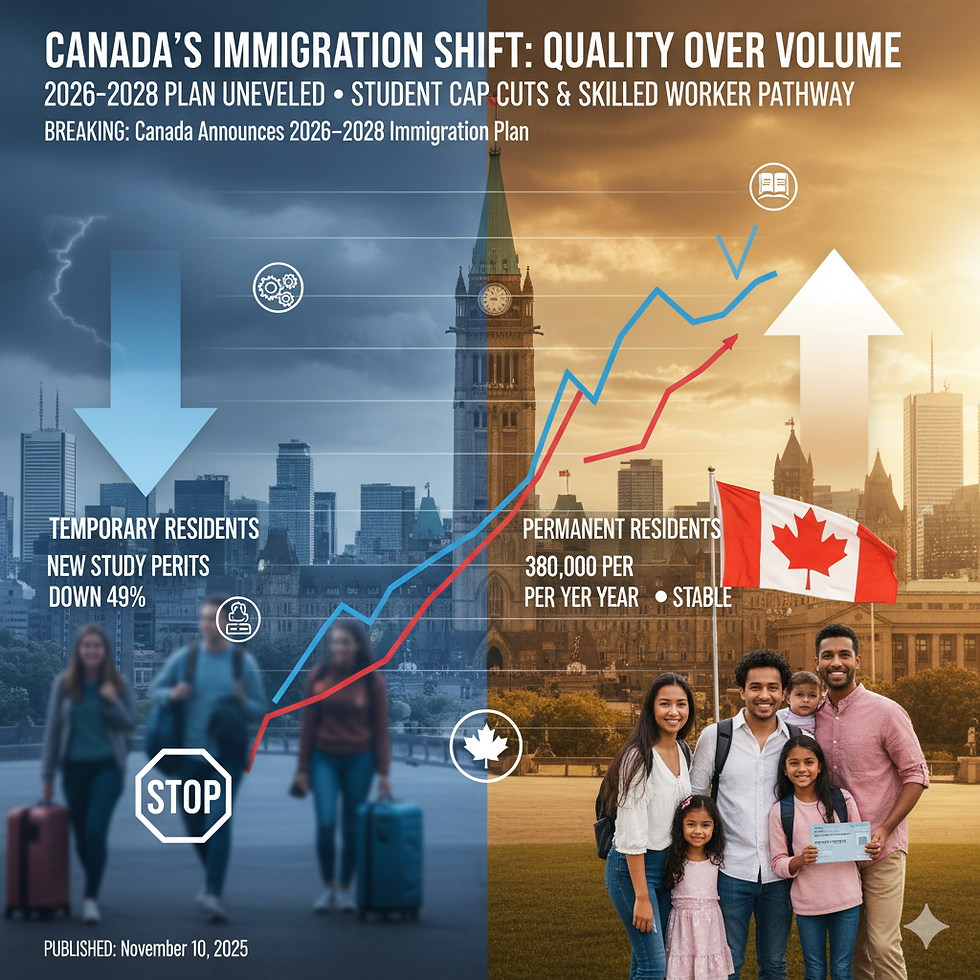Canada Immigration Changes 2025: Essential Updates for a Shifting Landscape
- Ardalan Ansari
- Feb 24
- 3 min read
Big changes are coming to Canada’s immigration system in 2025. Whether you’re planning to move to Canada, already here on a temporary permit, or employing newcomers, these policy shifts could have a direct impact on you. Below, you’ll find a detailed overview of what’s changing—and how to navigate it.
Table of Contents
Key Canada Immigration Changes 2025
In a notable policy shift, the Canadian government has announced lower immigration targets for the coming years—a move that underscores the Canada Immigration Changes 2025. The new plan outlines the admission of:
395,000 new permanent residents in 2025
380,000 in 2026
365,000 in 2027
This is down from 485,000 in 2024. Prime Minister Justin Trudeau has pointed to limited housing, strained infrastructure, and rising social service demands as key reasons for this adjustment (AP News). The goal is to ensure Canada can continue welcoming newcomers sustainably.
Express Entry System Updates
The Express Entry system, a primary avenue for economic immigration, is also seeing adjustments:
Bigger Share of Overall ImmigrationDespite overall target reductions, Express Entry’s portion is set to grow. The plan is to admit 124,590 immigrants through federal economic programs managed by Express Entry in 2025, up from 110,770 in 2024. This shift gives the federal government more control over economic immigration (CIC News).
Removal of Job Offer PointsBeginning in spring 2025, candidates will no longer earn Comprehensive Ranking System (CRS) points for valid job offers—previously worth up to 50–200 points based on the position. By eliminating these extra points, the government aims to level the playing field (CIC News).
Two New Sub-CategoriesThe Federal High-Skilled (FHS) allocation is being replaced by:
In-Canada Focus (82,890 spots): For candidates already living in Canada (CEC and Express Entry-aligned PNPs).
Federal Economic Priorities (41,700 spots): For applicants selected based on labor market needs (healthcare, skilled trades, and French speakers) (CIC News).
Provincial Nominee Program (PNP) Changes
Because some Express Entry spaces used to be allocated through provincial programs, these targets affect PNP streams as well:
Saskatchewan: Has paused intake for job-offer-based immigration pathways, which impacts those who rely on a provincial job offer.
Ontario: The Ontario Immigrant Nominee Program (OINP) will continue offering multiple streams, but a federal cutback in total nominations has forced Ontario to fine-tune its intake and allocations (CIC News).
Impact on Temporary Residents
Temporary residents—especially international students and foreign workers—are also seeing new policies:
International Students: Canada plans to issue 437,000 study permits in 2025, a 10% reduction from 2024. This is the second year of such limitations, aimed at easing pressure on housing and social services (Reuters).
Temporary Foreign Workers (TFWs): Stricter eligibility and caps will be introduced to ensure the program aligns with Canada’s economic needs and infrastructure capabilities (Reuters).
What This Means for Employers
If you’re an employer relying on foreign talent, these changes mean:
Strategic Workforce PlanningWith fewer permanent resident spots and stricter temporary worker policies, some industries may face labor shortages. Prepare by exploring local talent pools or enhancing retention strategies.
Stay on Top of RegulationsThe revised Express Entry system and new PNP allocations mean you’ll need to keep current on immigration rules. Consulting an immigration professional can help you navigate these evolving requirements.
Tips for Prospective Immigrants
Trying to move to Canada amid the Canada Immigration Changes 2025? Here’s how to stay ahead:
Keep Informed: Monitor official government websites and trusted news sources for updates.
Enhance Your Profile: Boost your language scores, accumulate relevant work experience, and consider further education if it aligns with priority sectors like healthcare or skilled trades.
Get Professional Advice: An immigration lawyer or consultant can guide you through the application process and help identify your best pathway.
Conclusion
The Canada Immigration Changes 2025 highlight the country’s effort to balance a welcoming immigration policy with real-world constraints—like housing and social services. Whether you’re a prospective immigrant or an employer, staying informed and planning strategically will help you adapt to the new landscape.




Comments